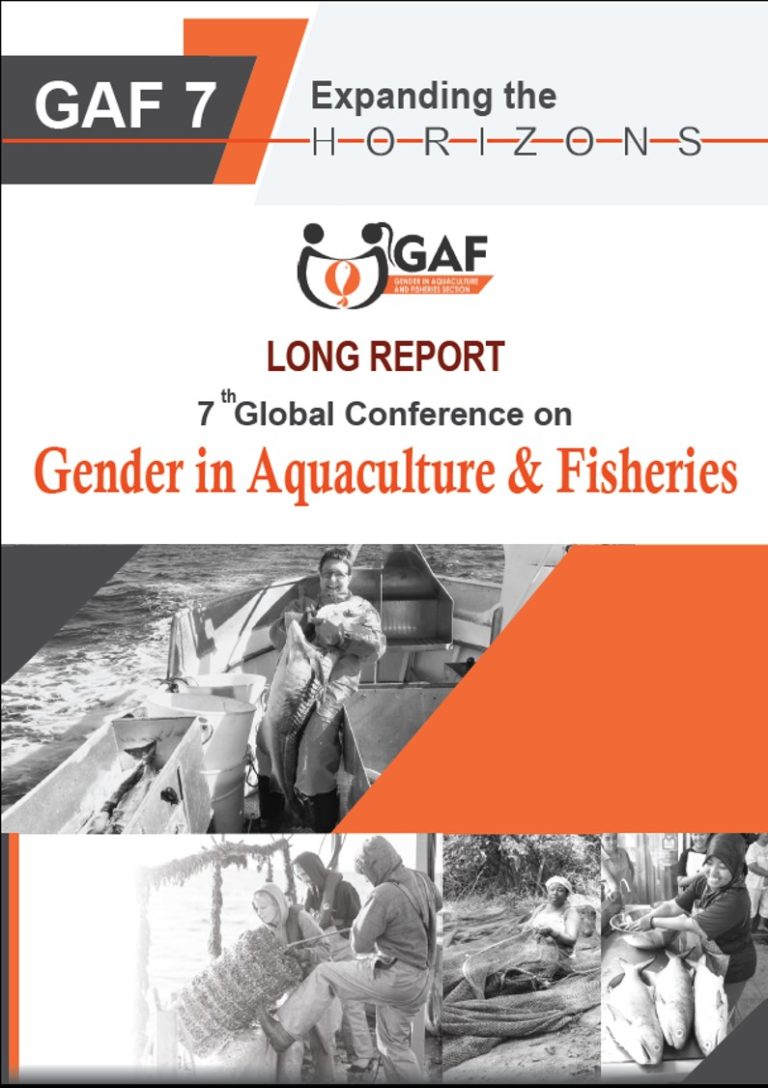Overview of the GAF7 Long Report
Download the full report of GAF7 here: GAF7_Long Report
The 7th Global Conference on Gender in Aquaculture and Fisheries (GAF7), held from 18-21 October 2018 at the Asian Institute of Technology, Bangkok, was organised by the Gender in Aquaculture and Fisheries Section (GAFS) of the Asian Fisheries Society (AFS), the Asian Institute of Technology and the Network of Aquaculture Centres in Asia Pacific. It followed 28 years of women and gender symposia and workshops supported by the AFS and its Indian Branch. GAF7 created a platform for sharing the latest gender in fisheries and aquaculture research, learning new methods and approaches, launching new training products and crafting a vision for the future of our research field. GAF7. Presenters and participants came from all continents. This report provides an overview of all the presentations.
Strong evidence exists that when women are made visible and given voice, changes start to take place. But miracles don’t happen overnight, most take a long time. Change is impeded by many factors and the lack of sex-disaggregated data in fisheries make change hard to assess. Added to the data gap is actual resistance to integrating gender equality into the sector. Sex-disaggregated data, if available at all, rarely extend beyond production data, thus omitting valuable information on the post-harvest and support services in which women’s participation is most prevalent. GAF7 presenters described their attempts to work around the lack of sex-disaggregated data by tapping into data inferred from a national fisheries census, institutional data and data collected by special studies. A panel-led discussion proposed empirical studies to work through model approaches, at the national level, for collecting sexdisaggregated data.
Despite the challenges of assessing change, a rich set of surveys and impact assessments provided GAF7 with rather sobering results. Several fisheries development assistance projects in Indonesia that were intended to include gender equality components barely did so; a survey of the seafood sector found women were indeed integrated into the sector but still experience many types of discrimination. In India, state and national fisheries policies overlook non-traditional women’s opportunities; women have been replaced in many nodes of the shrimp value chain by mechanisation and export market orientation; and capacity building programs for fish processing are mainly driven by the top-down demands of importers. Special Workshops explored gender indicators for small scale aquaculture certification, and monitoring the progress of implementing the Small Scale Fisheries Guidelines. Photovoice, a graphic image based research tool for impact assessment and other social science research was taught in a Special Workshop and used by a team of participants in assessing GAF7.
Some change can be self-initiated, especially by women’s collective action, of which GAF7 heard many fine examples from Africa (AWFISHNET), Asia (Bangladesh, Cambodia, Japan, Philippines and Thailand), the Caribbean and Mexico.
The impetus to progress toward gender equality comes from many quarters. GAF7 presenters and participants explored solutions like education for future experts and new gender-sensitive technologies to offer new opportunities such as in fish marketing in India, and to overcome emerging problems such as climate change impacts on seaweed and shrimp farming. Educators showed how, in India, Japan, Philippines and Thailand attempts to mainstream gender in fisheries education can meet with passive, active, and hidden resistance from colleagues and/or administration. Thus it becomes necessary to mainstream gender in the academic curriculums of fisheries science. Institutions testing gender transformative approaches found that backlash to innovations to help women can be reduced by engaging women and men together as agents of change.
Fisheries and aquaculture are not monolithic, as reflected in studies that focused on women in particular industry nodes such as seaweed growing and tuna landing ports. Women’s entrepreneurship was featured in “positive deviators” in Bangladesh, collectives in Japan, individual women’s stories in Nigeria, small scale oyster growers in the Philippines, and, in India, women traders in competitive value chains, and those balancing choices between fish and non-fish livelihoods.
Download the report: GAF7_Long Report
Citation
Meryl J Williams, Nikita Gopal, Rejula K, Carmen Pedroza-Gutiérrez, Arlene Nietes Satapornvanit, Paul Ramirez, Ananthan P.S., Mary Barby Badayos-Jover, Alita Roxas, Sijitha Mary C.X., Janine Pierce and Afrina Choudhury, 2019, Long Report GAF7: Expanding the Horizons The 7th Global Conference on Gender in Aquaculture & Fisheries, pp. 57.

